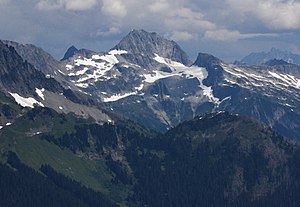Hurry-up peak
| Hurry-up peak | ||
|---|---|---|
|
Hurry-up Peak from the northwest |
||
| height | 2384 m (according to Peakbagger.com) | |
| location | Skagit County / Chelan County , Washington , USA | |
| Mountains | Northern Cascade Range | |
| Notch height | 323 m | |
| Coordinates | 48 ° 26 '2 " N , 121 ° 2' 17" W | |
|
|
||
| rock | Gneiss | |
| Normal way | over the Ptarmigan Traverse | |
| particularities | Watershed between the Stehekin River and the Cascade River | |
The Hurry-up peak (dt. About "Hurry-you-mountain") is a 2,384 meter high peak on the border between the counties Skagit and Chelan in the State of Washington . It lies on the main ridge of the North Cascades and forms the north end of the Ptarmigan Traverse . Hurry-up Peak is located southeast of Cascade Pass on the joint boundary of North Cascades National Park and the Glacier Peak Wilderness . The next higher peaks are Spider Mountain, (1.49 mi (2.4 km) south), Magic Mountain (0.83 mi (1.34 km) north), and Trapper Mountain (0.7 mi (1 , 1 km) east). Ess Mountain and S Mountain are variants of the Hurry-up Peak name. The S glacier is located on the eastern flank of the mountain; its meltwater flows into Trapper Lake. The superficial runoff from rainfall on the east side of the mountain feeds tributaries of the Stehekin River , while the west side is drained via the Cascade River .
climate
Hurry-up Peak lies in a climatic zone of western North America called the "Marine West Coast" . Most of the weather fronts originate from the Pacific and move northeast towards the Cascade Range . When the fronts reach the North Cascades , they are forced to rise by the high peaks, which sometimes leads to heavy precipitation in the form of rain or snow ( damming effect of the mountains ). This results in high amounts of precipitation on the west side of the cascades, especially in winter in the form of snow. During the winter months, the sky is usually overcast, but due to the high pressure systems over the Pacific, very often cloudless or very little cloudy in summer. Due to the maritime influence, the snow tends to be damp and therefore heavy, so that there is a high risk of avalanches .
geology
The North Cascades are home to some of the most rugged mountains and chains in the entire Cascade Range, as well as pointed peaks and ridges, deep trough valleys and granite peaks. Geological events a long time ago created this diverse topography and drastic height differences that led to the climatic differences. These differences led to a variety of vegetation conditions that are perceived as different ecoregions .
The history of the formation of the cascades goes back to the late Eocene , many millions of years ago. As the North American Plate pushed over the Pacific Plate , episodes of volcanism continued . In addition, small fragments of the oceanic and continental lithosphere , known as terrans , formed the North Cascades about 50 million years ago .
During the Pleistocene , which began about two million years ago, the repeatedly advancing and receding glaciers dug into the landscape, but also left behind deposits of rock debris. The U-shaped cross-sections of the river valleys are the result of the still ongoing glaciation. Uplifts and faults combined with glaciation were the dominant processes that created the high peaks and deep valleys of the North Cascades.
Individual evidence
- ↑ a b Hurry-up Peak, Washington . PeakBagger.com. Retrieved January 23, 2019.
- ↑ Hurry-up Peak ( English ) In: Geographic Names Information System . United States Geological Survey . Retrieved August 28, 2018.
- ^ A b c Fred W. Beckey: Cascade Alpine Guide, Climbing and High Routes . The Mountaineers Books, Seattle, WA 2008.
- ^ A b c d Arthur Kruckeberg: The Natural History of Puget Sound Country . University of Washington Press, 1991.
Web links
- North Cascades National Park - site of the National Park Service (English)
See also
| Mix-up peak | Magic Mountain |
Buckner Mountain Booker Mountain |

|
Trapper Mountain | |
|
Snowking Mountain Mount Formidable |
Spider Mountain |

